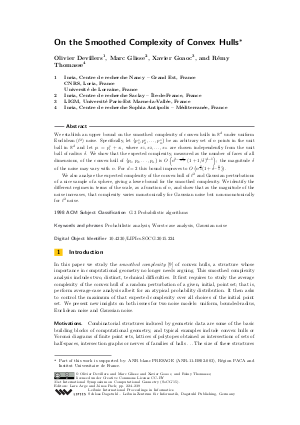On the Smoothed Complexity of Convex Hulls
Authors Olivier Devillers, Marc Glisse, Xavier Goaoc, Rémy Thomasse
-
Part of:
Volume:
31st International Symposium on Computational Geometry (SoCG 2015)
Part of: Series: Leibniz International Proceedings in Informatics (LIPIcs)
Part of: Conference: Symposium on Computational Geometry (SoCG) - License:
 Creative Commons Attribution 3.0 Unported license
Creative Commons Attribution 3.0 Unported license
- Publication Date: 2015-06-12
File

PDF
LIPIcs.SOCG.2015.224.pdf
- Filesize: 1.05 MB
- 16 pages
Document Identifiers
Subject Classification
Keywords
- Probabilistic analysis
- Worst-case analysis
- Gaussian noise
Metrics
- Access Statistics
-
Total Accesses (updated on a weekly basis)
0PDF Downloads0Metadata Views
Abstract
We establish an upper bound on the smoothed complexity of convex hulls in R^d under uniform Euclidean (L^2) noise. Specifically, let {p_1^*, p_2^*, ..., p_n^*} be an arbitrary set of n points in the unit ball in R^d and let p_i = p_i^* + x_i, where x_1, x_2, ..., x_n are chosen independently from the unit ball of radius r. We show that the expected complexity, measured as the number of faces of all dimensions, of the convex hull of {p_1, p_2, ..., p_n} is O(n^{2-4/(d+1)} (1+1/r)^{d-1}); the magnitude r of the noise may vary with n. For d=2 this bound improves to O(n^{2/3} (1+r^{-2/3})).
We also analyze the expected complexity of the convex hull of L^2 and Gaussian perturbations of a nice sample of a sphere, giving a lower-bound for the smoothed complexity. We identify the different regimes in terms of the scale, as a function of n, and show that as the magnitude of the noise increases, that complexity varies monotonically for Gaussian noise but non-monotonically for L^2 noise.
Cite As Get BibTex
Olivier Devillers, Marc Glisse, Xavier Goaoc, and Rémy Thomasse. On the Smoothed Complexity of Convex Hulls. In 31st International Symposium on Computational Geometry (SoCG 2015). Leibniz International Proceedings in Informatics (LIPIcs), Volume 34, pp. 224-239, Schloss Dagstuhl – Leibniz-Zentrum für Informatik (2015)
https://doi.org/10.4230/LIPIcs.SOCG.2015.224
BibTex
@InProceedings{devillers_et_al:LIPIcs.SOCG.2015.224,
author = {Devillers, Olivier and Glisse, Marc and Goaoc, Xavier and Thomasse, R\'{e}my},
title = {{On the Smoothed Complexity of Convex Hulls}},
booktitle = {31st International Symposium on Computational Geometry (SoCG 2015)},
pages = {224--239},
series = {Leibniz International Proceedings in Informatics (LIPIcs)},
ISBN = {978-3-939897-83-5},
ISSN = {1868-8969},
year = {2015},
volume = {34},
editor = {Arge, Lars and Pach, J\'{a}nos},
publisher = {Schloss Dagstuhl -- Leibniz-Zentrum f{\"u}r Informatik},
address = {Dagstuhl, Germany},
URL = {https://drops.dagstuhl.de/entities/document/10.4230/LIPIcs.SOCG.2015.224},
URN = {urn:nbn:de:0030-drops-51451},
doi = {10.4230/LIPIcs.SOCG.2015.224},
annote = {Keywords: Probabilistic analysis, Worst-case analysis, Gaussian noise}
}
Author Details
References
-
Robert M. Corless, Gaston H. Gonnet, D.E.G. Hare, David J. Jeffrey, and Donald E. Knuth. On the Lambert W function. Advances in Computational Mathematics, 5(1):329-359, 1996. http://dx.doi.org/10.1007/BF02124750.

-
Valentina Damerow and Christian Sohler. Extreme points under random noise. In Proc. 12th European Sympos. Algorithms, pages 264-274, 2004. http://dx.doi.org/10.1007/978-3-540-30140-0_25.

-
Mark de Berg, Herman Haverkort, and Constantinos P. Tsirogiannis. Visibility maps of realistic terrains have linear smoothed complexity. Journal of Computational Geometry, 1:57-71, 2010. http://jocg.org/index.php/jocg/article/view/12.

-
Olivier Devillers, Marc Glisse, and Xavier Goaoc. Complexity analysis of random geometric structures made simpler. In Symposium on Computational Geometry, pages 167-176, 2013. http://dx.doi.org/10.1145/2462356.2462362.

-
Marc Glisse, Sylvain Lazard, Julien Michel, and Marc Pouget. Silhouette of a random polytope. Research Report 8327, INRIA, 2013. http://hal.inria.fr/hal-00841374/.

-
Matthias Reitzner. Random polytopes. In New perspectives in stochastic geometry, pages 45-76. Oxford Univ. Press, Oxford, 2010.

-
Alfréd Rényi and Rolf Sulanke. Über die konvexe Hülle von n zufällig gewählten Punkten I. Z. Wahrsch. Verw. Gebiete, 2:75-84, 1963. http://dx.doi.org/10.1007/BF00535300.

-
Alfréd Rényi and Rolf Sulanke. Über die konvexe Hülle von n zufällig gewählten Punkten II. Z. Wahrsch. Verw. Gebiete, 3:138-147, 1964. http://dx.doi.org/10.1007/BF00535973.

-
Daniel A. Spielman and Shang-Hua Teng. Smoothed analysis: Why the simplex algorithm usually takes polynomial time. Journal of the ACM, 51:385-463, 2004. http://dx.doi.org/10.1145/990308.990310.

